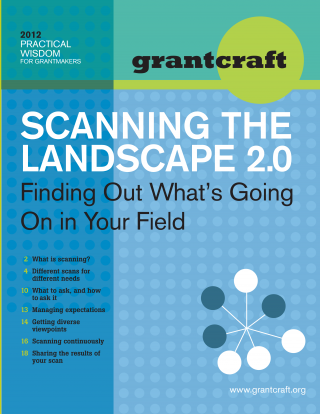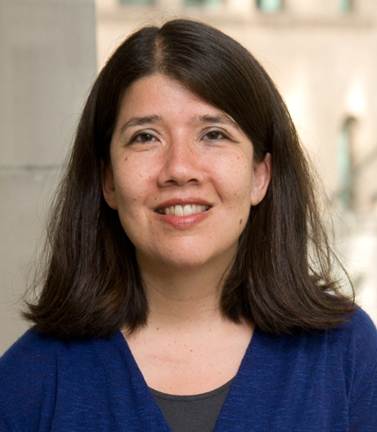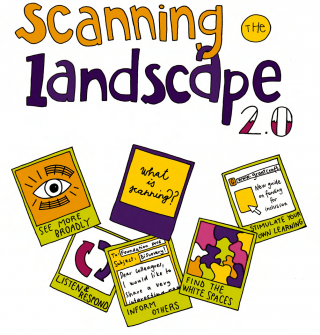Scanning the Landscape 2.0 Finding Out What’s Going on in Your Field
We talked with funders working in the US, Europe, and internationally about when, why, and how it’s useful to scan the landscape for new ideas and new directions. This updated edition of a 2004 GrantCraft guide reflects key changes in philanthropy, from the rise of social media to a growing tendency to scan continuously for changes and opportunities.
Highlights
- What to ask, and how to ask it
- Using data visualization for your learning
- Online tools for scanning
What's in the Guide?
- What is Scanning? To understand how your efforts fit within a wider field of activity, it's often useful to look at the field as a whole to see where the opportunities, needs, and gaps are. That's what we mean by "scanning." A scan can help you adjust to a new position, learn a new field, take a fresh look at grants you've already made, keep current with larger trends, or chart a course for the future.
- Different Scans for Different Needs: Funders use scans for many reasons. Scans don't have to be long and complicated – but a thorough scan can be well worth the time and effort. This section explores various reasons for scanning and describes a range of approaches to meet particular needs.
- What to ask, and how to ask it: Once you've framed the purpose of your scan, what kind of questions should you ask? And what's the best way to ask them? This section offers advice on eliciting the information you're looking for, pulling people together to share ideas, being a good listener, and leaving room for unexpected learning.
- Managing expectations: Once a funder starts asking questions, holding meetings, and seeking out advice on a given topic, people in the field are likely to notice and become curious. Here are some tips on how to give a clear impression of what you're doing and how to manage the understandable hopes of people who would like to receive support.
- Getting diverse viewpoints: A scan can be particularly useful when it concentrates on aspects of the field you don't know about, people you haven't heard from, and issues you hadn't considered before. This section offers some tested methods for soliciting unfamiliar ideas, meeting new people, and encouraging candid views and input.
- Scanning continuously: These days, many funders treat scanning as a more or less continuous activity – a frame of mind or set of routines that helps them stay aware of the larger context, open to new ideas, and connected with broader networks.
- Sharing the results of your scan: There are many ways to put the information you uncover to use, both within your foundation and in the field. Here, our contributors share ideas about how to use a scan and its results for the widest possible benefit.

Categories
Content type
-
Link to Scanning and Networking
Sharing the Results of Your Scan
With effort, a scan can contribute to the knowledge and effectiveness of an entire foundation, other organizations, and the field as a whole in a number of ways:
Read more -
Link to Scanning and Networking
Online Tools for Scanning
- Philanthropy News Digest is a daily online news service dedicated to philanthropy.
- IssueLab archives, distributes, and promotes the exten- sive and diverse body of research being produced by the nonprofit sector.
-
Link to Scanning and Networking
Scanning Social Media
Facebook, Google Alerts, Twitter, blogs, and other social media activity: To “track the pulse” of activity in education policy, one American grantmaker regularly follows a select group of blogs and Twitter feeds, “not just by policy wonks but by teachers and others whose opinions I respect, on both sides of many arguments, although they can be very ideological sometimes.”
Read more -
Link to Scanning and Networking
Why Scan? Map the Funding Landscape
If you’re looking for a unique niche or an opportunity to align and collaborate with others, a scan can uncover who else is supporting work in a particular field or geographic area. But a scan can yield more than a census of funding sources. Scanning techniques can help get below the surface of other funders’ interests, build relationships, and sharpen your own ongoing strategy development.
Read more -
Link to Scanning and Networking
Scanning Continuously
For many funders, scanning is more than just an occasional thing, reserved for periods of strategic planning and reflection. Instead, they see it as a continuous set of activities that help them stay current and alert to opportunities.
Read more -
Link to Scanning and Networking
Getting a Good Discussion Going
Here are some questions to get people talking about what needs to be done in their field or community.
Read more -
Link to Scanning and Networking
Getting Diverse Viewpoints
Seek out contrary points of view. It’s essential to hear from people you don’t agree with, and to find out what they read, whom they talk to, and where they get their information. One funder explained his approach: “I’m always open to talking with people I don’t agree with because I want to learn what their position is.
Read more -
Link to Scanning and Networking
Managing Expectations in Landscape Scanning
Recognize that scanning inevitably raises hopes of a possible grant. Consulting potential grantees during a scan “obviously generates expectations,” said one funder.
Read more -
Link to Scanning and Networking
Scanning Tools/Practices
To get the best and most unvarnished answers to your questions, consider the following scanning techniques to supplement your individual interviews.
Read more -
Link to Scanning and Networking
What They Did, How They Did It: Framing Research Questions Together
When program officers from two foundations decided to team up to hire an expert consulting group for a scan that would serve the learning needs of both, they put their heads together to decide what research questions to ask. Later, as the results came in, they conferred frequently with the consultants about what the research was uncovering and what further questions to ask. One described the process:
Read more
We talked with funders working in the US, Europe, and internationally about when, why, and how it’s useful to scan the landscape for new ideas and new directions. This updated edition of a 2004 GrantCraft guide reflects key changes in philanthropy, from the rise of social media to a growing tendency to scan continuously for changes and opportunities.
Highlights
- What to ask, and how to ask it
- Using data visualization for your learning
- Online tools for scanning
What's in the Guide?
- What is Scanning? To understand how your efforts fit within a wider field of activity, it's often useful to look at the field as a whole to see where the opportunities, needs, and gaps are. That's what we mean by "scanning." A scan can help you adjust to a new position, learn a new field, take a fresh look at grants you've already made, keep current with larger trends, or chart a course for the future.
- Different Scans for Different Needs: Funders use scans for many reasons. Scans don't have to be long and complicated – but a thorough scan can be well worth the time and effort. This section explores various reasons for scanning and describes a range of approaches to meet particular needs.
- What to ask, and how to ask it: Once you've framed the purpose of your scan, what kind of questions should you ask? And what's the best way to ask them? This section offers advice on eliciting the information you're looking for, pulling people together to share ideas, being a good listener, and leaving room for unexpected learning.
- Managing expectations: Once a funder starts asking questions, holding meetings, and seeking out advice on a given topic, people in the field are likely to notice and become curious. Here are some tips on how to give a clear impression of what you're doing and how to manage the understandable hopes of people who would like to receive support.
- Getting diverse viewpoints: A scan can be particularly useful when it concentrates on aspects of the field you don't know about, people you haven't heard from, and issues you hadn't considered before. This section offers some tested methods for soliciting unfamiliar ideas, meeting new people, and encouraging candid views and input.
- Scanning continuously: These days, many funders treat scanning as a more or less continuous activity – a frame of mind or set of routines that helps them stay aware of the larger context, open to new ideas, and connected with broader networks.
- Sharing the results of your scan: There are many ways to put the information you uncover to use, both within your foundation and in the field. Here, our contributors share ideas about how to use a scan and its results for the widest possible benefit.



